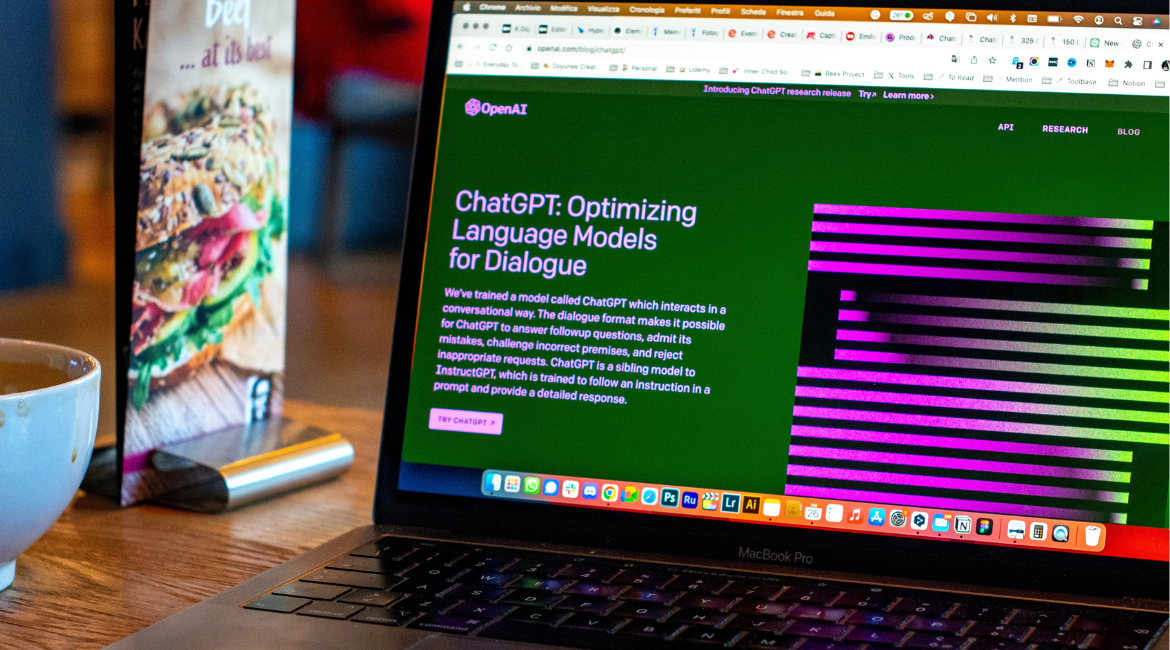blog
March 21, 2023
•6 min read
10 AI tools for developers you should know about in 2023

The march of Artificial Intelligence (AI), has reached a breakneck speed in recent years and is very likely to continue to speed up in 2023. OpenAI launched its ChatGPT (Chat Generative Pre-trained Transformer) chatbot in late 2022. While an imperfect prototype. It still attracted widespread attention for its ability to give articulate and detailed answers to diverse questions. AI opens new possibilities to developers too. Let’s take a look at 10 AI tools for developers you should definitely know about.
As proven in the fight against the COVID-19 pandemic, the advantage of AI systems is that they can complete code and consume large amounts of text and data much faster than humans can.
This is the case, particularly in the completion of the “microstasks,” which developers, programmers, and data scientists previously had to perform. In coding, there are numerous repetitive, mundane tasks that AI code completion applications have the potential to completely eliminate.
Related topic: The best programming languages for app development
AI-Powered Code Completion
For developers, programmers, and data scientists, AI coding solutions can free up thinking time, allowing such professionals to focus on the fundamentals of their projects, and complete such projects much faster.
Below are ten of the AI tools for code completion that developers can employ in 2023.
1. OpenAI Codex
OpenAI Codex is an AI tool that translates natural language into code. OpenAI Codex builds upon and improves GiftHub Copilot (see below), and was created and launched back in 2021 as part of a partnership between OpenAI and GiftHub. The improved model is proficient in over a dozen languages, can interpret simple commands in natural language, and translate them into code such as JavaScript, PHP, Perl, and Go.
2. Code T5
Code T5 is a “code-aware encoder-decoder based pre-trained programming language model.” An open-source model, CodeT5 can potentially bring three capabilities to software programming. These are:
- Text-to-code generation: Code T5 can generate code based on a natural language description.
- Code autocompletion: Code T5 can automatically complete the whole function of code given a target function name.
- Code summarization: Code T5 can generate the summary of a function in natural language description.
3. Tabnine
Tabnine is an AI assistant for software developers which “codes faster with “whole-line and full function code completions” and claims to be an “AI code assistant that makes you a better developer.” While it supports in excess of twenty languages and fifteen editors, Tabnine is not an end-to-end code generator. Tabnine makes much of its next-level auto-completion features in its integrated development environment or IDE, which incorporates IDEs such as IntelliJ, VS Code, and Android Studio.
Related post: How AI-powered software development is changing the role of the CTO and what CTOs should know about AI software development.
A Microsoft tool, marketed as allowing programmers and developers to “type less, code more.” Visual Studio Intellicode provides smart suggestions for code completion based on current code and context. This is achieved through using variable names and positions, the IntelliSense list, the libraries the programmer uses, and other sources. The tool includes a whole line code completion feature, which predicts the next segment of code.
While GiftHub Copilot’s creators’ collaboration with OpenAI Codex built upon and improved GiftHub Copilot, which is now described as an “AI pair programmer, GitHub Copilot uses the OpenAI Codex to suggest code and entire functions in real-time, right from your editor.” GiftHub Copilot is a very popular and efficient open-source completion AI tool. The tool provides suggestions for complete lines or whole functions inside a code editor. GiftHub also provides alternative coding suggestions, is responsive to previous edits, and is responsive to an individual programmer or developer’s coding style.
6. Cogram
Cogram is a code-generation tool aimed at data scientists and developers using Python and Julia. Integratable with Jupyter notebooks to automatically generate code, one of Cogram’s key capabilities is that it handles written queries in English, which the tool translates into complex Structured Query Language (SQL) queries. Cogram can generate contextual code for specific tasks based only on comments. Cogram espouses its ability to cut down the time people spend on meetings in terms of note-taking and following up actions - “Cogram uses state-of-the-art AI to generate high-quality minutes, identify action items, and summarise your meetings.”
7. Polycoder
Polycoder is one of the first open-source code generation models and can be classed as an AI system that, like OpenAI Codex, translates natural language into complex code. Polycoder’s key sales point is built on the claim that it is more capable of writing code from natural language than any other model, including the much more widely-known OpenAI Codex.
8. PyCharm
PyCharm is an integrated development environment, which is made exclusively for use by Python and Jupyter developers. As well as intelligent code completion, users can run ad-hoc commands, supports error checking on the move, seamless project navigation, and quick fixes. Other features include - Pycharm shows users their plots inside the IDE and automatically keeps track of the last plots the programmer created to make it easier for them to spot changes between two plots, and Pycharm also includes automatic formatting once commands are complete.
You might be also interested in: How Artificial Intelligence is changing web development
9. WingPro
Designed exclusively for Python, Wing Pro is “a full-featured Python IDE designed for professional developers, and includes powerful editing, code intelligence, refactoring, debugging, search, unit testing, project management, revision control, and remote development features.” Wing Pro is an intelligent editor that analyses code, offers smart error-checking, and integrated Python-shells features.
10. Ponicode
Ponicode asks the programmer to become “a code quality hero” by being spared mundane coding tasks and states “we build tools that allow teams to meet deadlines, without sacrificing code quality.” Ponicode, which works on Java, Python, JavaScript, and TypeScript, makes great play of its speed, both in its installation and in the execution of code. This tool also facilitates the development of software for eliminating bugs and flaws.
Read also: 15 useful web app development tools
Conclusion
AI code generation systems are becoming increasingly popular, with OpenAI Codex and Polycoder being two of the most widely-known tools available. Popular development environments like PyCharm, WingPro and Cogram offer developers intelligent coding features and debugging capabilities in real-time. Finally, Ponicode offers a robust solution for eliminating software bugs and flaws quickly and effectively.
Ultimately, these AI code generation tools come with a lot of promise but it’s up to developers to decide which one is best suited for their particular coding needs. With all these in mind, it’s clear that AI-powered coding solutions are here to stay and they are changing the way we code. From better debugging capabilities to faster code generation, these AI-powered tools are revolutionizing the way software is created and making coding easier and more efficient.
As the AI and machine learning industry advances, so will these AI code generation tools and developers need to stay on top of trends and keep up with the latest AI tools for developers. Happy coding!
Learn more from our insights

NOVEMBER 3, 2025 • 7 min read
CE marking software under the EU AI Act – who needs it and how to prepare a conformity assessment
From 2026, AI systems classified as high-risk under the EU Artificial Intelligence Act (Regulation (EU) 2024/1689) will have to undergo a conformity assessment and obtain a CE marking before being placed on the EU market or put into service.

October 19, 2025 • 7 min read
EU and UK AI regulation compared: implications for software, data, and AI projects
Both the European Union and the United Kingdom are shaping distinct—but increasingly convergent—approaches to AI regulation.
For companies developing or deploying AI solutions across both regions, understanding these differences is not an academic exercise. It directly affects how software and data projects are planned, documented, and maintained.

October 9, 2025 • 5 min read
When AI and GDPR meet: navigating the tension between AI and data protection
When AI-powered systems process or generate personal data, they enter a regulatory minefield — especially under the EU’s General Data Protection Regulation (GDPR) and the emerging EU AI Act regime

September 17, 2025 • 4 min read
6 AI integration use cases enterprises can adopt for automation and decision support
The question for most companies is no longer if they should use AI, but where it will bring a measurable impact.
The journey to your
custom software
solution starts here.
Services
Let's talk!
blog
March 21, 2023
•6 min read
10 AI tools for developers you should know about in 2023

The march of Artificial Intelligence (AI), has reached a breakneck speed in recent years and is very likely to continue to speed up in 2023. OpenAI launched its ChatGPT (Chat Generative Pre-trained Transformer) chatbot in late 2022. While an imperfect prototype. It still attracted widespread attention for its ability to give articulate and detailed answers to diverse questions. AI opens new possibilities to developers too. Let’s take a look at 10 AI tools for developers you should definitely know about.
As proven in the fight against the COVID-19 pandemic, the advantage of AI systems is that they can complete code and consume large amounts of text and data much faster than humans can.
This is the case, particularly in the completion of the “microstasks,” which developers, programmers, and data scientists previously had to perform. In coding, there are numerous repetitive, mundane tasks that AI code completion applications have the potential to completely eliminate.
Related topic: The best programming languages for app development
AI-Powered Code Completion
For developers, programmers, and data scientists, AI coding solutions can free up thinking time, allowing such professionals to focus on the fundamentals of their projects, and complete such projects much faster.
Below are ten of the AI tools for code completion that developers can employ in 2023.
1. OpenAI Codex
OpenAI Codex is an AI tool that translates natural language into code. OpenAI Codex builds upon and improves GiftHub Copilot (see below), and was created and launched back in 2021 as part of a partnership between OpenAI and GiftHub. The improved model is proficient in over a dozen languages, can interpret simple commands in natural language, and translate them into code such as JavaScript, PHP, Perl, and Go.
2. Code T5
Code T5 is a “code-aware encoder-decoder based pre-trained programming language model.” An open-source model, CodeT5 can potentially bring three capabilities to software programming. These are:
- Text-to-code generation: Code T5 can generate code based on a natural language description.
- Code autocompletion: Code T5 can automatically complete the whole function of code given a target function name.
- Code summarization: Code T5 can generate the summary of a function in natural language description.
3. Tabnine
Tabnine is an AI assistant for software developers which “codes faster with “whole-line and full function code completions” and claims to be an “AI code assistant that makes you a better developer.” While it supports in excess of twenty languages and fifteen editors, Tabnine is not an end-to-end code generator. Tabnine makes much of its next-level auto-completion features in its integrated development environment or IDE, which incorporates IDEs such as IntelliJ, VS Code, and Android Studio.
Related post: How AI-powered software development is changing the role of the CTO and what CTOs should know about AI software development.
A Microsoft tool, marketed as allowing programmers and developers to “type less, code more.” Visual Studio Intellicode provides smart suggestions for code completion based on current code and context. This is achieved through using variable names and positions, the IntelliSense list, the libraries the programmer uses, and other sources. The tool includes a whole line code completion feature, which predicts the next segment of code.
While GiftHub Copilot’s creators’ collaboration with OpenAI Codex built upon and improved GiftHub Copilot, which is now described as an “AI pair programmer, GitHub Copilot uses the OpenAI Codex to suggest code and entire functions in real-time, right from your editor.” GiftHub Copilot is a very popular and efficient open-source completion AI tool. The tool provides suggestions for complete lines or whole functions inside a code editor. GiftHub also provides alternative coding suggestions, is responsive to previous edits, and is responsive to an individual programmer or developer’s coding style.
6. Cogram
Cogram is a code-generation tool aimed at data scientists and developers using Python and Julia. Integratable with Jupyter notebooks to automatically generate code, one of Cogram’s key capabilities is that it handles written queries in English, which the tool translates into complex Structured Query Language (SQL) queries. Cogram can generate contextual code for specific tasks based only on comments. Cogram espouses its ability to cut down the time people spend on meetings in terms of note-taking and following up actions - “Cogram uses state-of-the-art AI to generate high-quality minutes, identify action items, and summarise your meetings.”
7. Polycoder
Polycoder is one of the first open-source code generation models and can be classed as an AI system that, like OpenAI Codex, translates natural language into complex code. Polycoder’s key sales point is built on the claim that it is more capable of writing code from natural language than any other model, including the much more widely-known OpenAI Codex.
8. PyCharm
PyCharm is an integrated development environment, which is made exclusively for use by Python and Jupyter developers. As well as intelligent code completion, users can run ad-hoc commands, supports error checking on the move, seamless project navigation, and quick fixes. Other features include - Pycharm shows users their plots inside the IDE and automatically keeps track of the last plots the programmer created to make it easier for them to spot changes between two plots, and Pycharm also includes automatic formatting once commands are complete.
You might be also interested in: How Artificial Intelligence is changing web development
9. WingPro
Designed exclusively for Python, Wing Pro is “a full-featured Python IDE designed for professional developers, and includes powerful editing, code intelligence, refactoring, debugging, search, unit testing, project management, revision control, and remote development features.” Wing Pro is an intelligent editor that analyses code, offers smart error-checking, and integrated Python-shells features.
10. Ponicode
Ponicode asks the programmer to become “a code quality hero” by being spared mundane coding tasks and states “we build tools that allow teams to meet deadlines, without sacrificing code quality.” Ponicode, which works on Java, Python, JavaScript, and TypeScript, makes great play of its speed, both in its installation and in the execution of code. This tool also facilitates the development of software for eliminating bugs and flaws.
Read also: 15 useful web app development tools
Conclusion
AI code generation systems are becoming increasingly popular, with OpenAI Codex and Polycoder being two of the most widely-known tools available. Popular development environments like PyCharm, WingPro and Cogram offer developers intelligent coding features and debugging capabilities in real-time. Finally, Ponicode offers a robust solution for eliminating software bugs and flaws quickly and effectively.
Ultimately, these AI code generation tools come with a lot of promise but it’s up to developers to decide which one is best suited for their particular coding needs. With all these in mind, it’s clear that AI-powered coding solutions are here to stay and they are changing the way we code. From better debugging capabilities to faster code generation, these AI-powered tools are revolutionizing the way software is created and making coding easier and more efficient.
As the AI and machine learning industry advances, so will these AI code generation tools and developers need to stay on top of trends and keep up with the latest AI tools for developers. Happy coding!
Learn more from our insights

NOVEMBER 3, 2025 • 7 min read
CE marking software under the EU AI Act – who needs it and how to prepare a conformity assessment
From 2026, AI systems classified as high-risk under the EU Artificial Intelligence Act (Regulation (EU) 2024/1689) will have to undergo a conformity assessment and obtain a CE marking before being placed on the EU market or put into service.

October 19, 2025 • 7 min read
EU and UK AI regulation compared: implications for software, data, and AI projects
Both the European Union and the United Kingdom are shaping distinct—but increasingly convergent—approaches to AI regulation.
For companies developing or deploying AI solutions across both regions, understanding these differences is not an academic exercise. It directly affects how software and data projects are planned, documented, and maintained.

October 9, 2025 • 5 min read
When AI and GDPR meet: navigating the tension between AI and data protection
When AI-powered systems process or generate personal data, they enter a regulatory minefield — especially under the EU’s General Data Protection Regulation (GDPR) and the emerging EU AI Act regime

September 17, 2025 • 4 min read
6 AI integration use cases enterprises can adopt for automation and decision support
The question for most companies is no longer if they should use AI, but where it will bring a measurable impact.
The journey to your
custom software
solution starts here.
Services
Head Office
Revoluční 1
110 00, Prague Czech Republic
hello@blocshop.io
Let's talk!
blog
March 21, 2023
•6 min read
10 AI tools for developers you should know about in 2023

The march of Artificial Intelligence (AI), has reached a breakneck speed in recent years and is very likely to continue to speed up in 2023. OpenAI launched its ChatGPT (Chat Generative Pre-trained Transformer) chatbot in late 2022. While an imperfect prototype. It still attracted widespread attention for its ability to give articulate and detailed answers to diverse questions. AI opens new possibilities to developers too. Let’s take a look at 10 AI tools for developers you should definitely know about.
As proven in the fight against the COVID-19 pandemic, the advantage of AI systems is that they can complete code and consume large amounts of text and data much faster than humans can.
This is the case, particularly in the completion of the “microstasks,” which developers, programmers, and data scientists previously had to perform. In coding, there are numerous repetitive, mundane tasks that AI code completion applications have the potential to completely eliminate.
Related topic: The best programming languages for app development
AI-Powered Code Completion
For developers, programmers, and data scientists, AI coding solutions can free up thinking time, allowing such professionals to focus on the fundamentals of their projects, and complete such projects much faster.
Below are ten of the AI tools for code completion that developers can employ in 2023.
1. OpenAI Codex
OpenAI Codex is an AI tool that translates natural language into code. OpenAI Codex builds upon and improves GiftHub Copilot (see below), and was created and launched back in 2021 as part of a partnership between OpenAI and GiftHub. The improved model is proficient in over a dozen languages, can interpret simple commands in natural language, and translate them into code such as JavaScript, PHP, Perl, and Go.
2. Code T5
Code T5 is a “code-aware encoder-decoder based pre-trained programming language model.” An open-source model, CodeT5 can potentially bring three capabilities to software programming. These are:
- Text-to-code generation: Code T5 can generate code based on a natural language description.
- Code autocompletion: Code T5 can automatically complete the whole function of code given a target function name.
- Code summarization: Code T5 can generate the summary of a function in natural language description.
3. Tabnine
Tabnine is an AI assistant for software developers which “codes faster with “whole-line and full function code completions” and claims to be an “AI code assistant that makes you a better developer.” While it supports in excess of twenty languages and fifteen editors, Tabnine is not an end-to-end code generator. Tabnine makes much of its next-level auto-completion features in its integrated development environment or IDE, which incorporates IDEs such as IntelliJ, VS Code, and Android Studio.
Related post: How AI-powered software development is changing the role of the CTO and what CTOs should know about AI software development.
A Microsoft tool, marketed as allowing programmers and developers to “type less, code more.” Visual Studio Intellicode provides smart suggestions for code completion based on current code and context. This is achieved through using variable names and positions, the IntelliSense list, the libraries the programmer uses, and other sources. The tool includes a whole line code completion feature, which predicts the next segment of code.
While GiftHub Copilot’s creators’ collaboration with OpenAI Codex built upon and improved GiftHub Copilot, which is now described as an “AI pair programmer, GitHub Copilot uses the OpenAI Codex to suggest code and entire functions in real-time, right from your editor.” GiftHub Copilot is a very popular and efficient open-source completion AI tool. The tool provides suggestions for complete lines or whole functions inside a code editor. GiftHub also provides alternative coding suggestions, is responsive to previous edits, and is responsive to an individual programmer or developer’s coding style.
6. Cogram
Cogram is a code-generation tool aimed at data scientists and developers using Python and Julia. Integratable with Jupyter notebooks to automatically generate code, one of Cogram’s key capabilities is that it handles written queries in English, which the tool translates into complex Structured Query Language (SQL) queries. Cogram can generate contextual code for specific tasks based only on comments. Cogram espouses its ability to cut down the time people spend on meetings in terms of note-taking and following up actions - “Cogram uses state-of-the-art AI to generate high-quality minutes, identify action items, and summarise your meetings.”
7. Polycoder
Polycoder is one of the first open-source code generation models and can be classed as an AI system that, like OpenAI Codex, translates natural language into complex code. Polycoder’s key sales point is built on the claim that it is more capable of writing code from natural language than any other model, including the much more widely-known OpenAI Codex.
8. PyCharm
PyCharm is an integrated development environment, which is made exclusively for use by Python and Jupyter developers. As well as intelligent code completion, users can run ad-hoc commands, supports error checking on the move, seamless project navigation, and quick fixes. Other features include - Pycharm shows users their plots inside the IDE and automatically keeps track of the last plots the programmer created to make it easier for them to spot changes between two plots, and Pycharm also includes automatic formatting once commands are complete.
You might be also interested in: How Artificial Intelligence is changing web development
9. WingPro
Designed exclusively for Python, Wing Pro is “a full-featured Python IDE designed for professional developers, and includes powerful editing, code intelligence, refactoring, debugging, search, unit testing, project management, revision control, and remote development features.” Wing Pro is an intelligent editor that analyses code, offers smart error-checking, and integrated Python-shells features.
10. Ponicode
Ponicode asks the programmer to become “a code quality hero” by being spared mundane coding tasks and states “we build tools that allow teams to meet deadlines, without sacrificing code quality.” Ponicode, which works on Java, Python, JavaScript, and TypeScript, makes great play of its speed, both in its installation and in the execution of code. This tool also facilitates the development of software for eliminating bugs and flaws.
Read also: 15 useful web app development tools
Conclusion
AI code generation systems are becoming increasingly popular, with OpenAI Codex and Polycoder being two of the most widely-known tools available. Popular development environments like PyCharm, WingPro and Cogram offer developers intelligent coding features and debugging capabilities in real-time. Finally, Ponicode offers a robust solution for eliminating software bugs and flaws quickly and effectively.
Ultimately, these AI code generation tools come with a lot of promise but it’s up to developers to decide which one is best suited for their particular coding needs. With all these in mind, it’s clear that AI-powered coding solutions are here to stay and they are changing the way we code. From better debugging capabilities to faster code generation, these AI-powered tools are revolutionizing the way software is created and making coding easier and more efficient.
As the AI and machine learning industry advances, so will these AI code generation tools and developers need to stay on top of trends and keep up with the latest AI tools for developers. Happy coding!
Learn more from our insights

NOVEMBER 20, 2025 • 7 min read
The ultimate CTO checklist for planning a custom software or AI project in 2026
In 2026, planning a successful project means understanding five essential dimensions before any code is written. These five questions define scope, architecture, delivery speed, and budget more accurately than any traditional project brief.
NOVEMBER 13, 2025 • 7 min read
The quiet cost of AI: shadow compute budgets and the new DevOps blind spot
AI projects rarely fail because the model “isn’t smart enough.” They fail because the money meter spins where few teams are watching: GPU hours, token bills, data egress, and serving inefficiencies that quietly pile up after launch.

NOVEMBER 3, 2025 • 7 min read
CE marking software under the EU AI Act – who needs it and how to prepare a conformity assessment
From 2026, AI systems classified as high-risk under the EU Artificial Intelligence Act (Regulation (EU) 2024/1689) will have to undergo a conformity assessment and obtain a CE marking before being placed on the EU market or put into service.

October 19, 2025 • 7 min read
EU and UK AI regulation compared: implications for software, data, and AI projects
Both the European Union and the United Kingdom are shaping distinct—but increasingly convergent—approaches to AI regulation.
For companies developing or deploying AI solutions across both regions, understanding these differences is not an academic exercise. It directly affects how software and data projects are planned, documented, and maintained.

October 9, 2025 • 5 min read
When AI and GDPR meet: navigating the tension between AI and data protection
When AI-powered systems process or generate personal data, they enter a regulatory minefield — especially under the EU’s General Data Protection Regulation (GDPR) and the emerging EU AI Act regime

September 17, 2025 • 4 min read
6 AI integration use cases enterprises can adopt for automation and decision support
The question for most companies is no longer if they should use AI, but where it will bring a measurable impact.
NOVEMBER 13, 2025 • 7 min read
The quiet cost of AI: shadow compute budgets and the new DevOps blind spot
AI projects rarely fail because the model “isn’t smart enough.” They fail because the money meter spins where few teams are watching: GPU hours, token bills, data egress, and serving inefficiencies that quietly pile up after launch.
NOVEMBER 13, 2025 • 7 min read
The quiet cost of AI: shadow compute budgets and the new DevOps blind spot
AI projects rarely fail because the model “isn’t smart enough.” They fail because the money meter spins where few teams are watching: GPU hours, token bills, data egress, and serving inefficiencies that quietly pile up after launch.

N 19, 2025 • 7 min read
CE Marking Software Under the EU AI Act – Who Needs It and How to Prepare a Conformity Assessment
When AI-powered systems process or generate personal data, they enter a regulatory minefield — especially under the EU’s General Data Protection Regulation (GDPR) and the emerging EU AI Act regime

NOVEMBER 13, 2025 • 7 min read
The quiet cost of AI: shadow compute budgets and the new DevOps blind spot
When AI-powered systems process or generate personal data, they enter a regulatory minefield — especially under the EU’s General Data Protection Regulation (GDPR) and the emerging EU AI Act regime

N 19, 2025 • 7 min read
CE Marking Software Under the EU AI Act – Who Needs It and How to Prepare a Conformity Assessment
When AI-powered systems process or generate personal data, they enter a regulatory minefield — especially under the EU’s General Data Protection Regulation (GDPR) and the emerging EU AI Act regime

NOVEMBER 13, 2025 • 7 min read
The quiet cost of AI: shadow compute budgets and the new DevOps blind spot
When AI-powered systems process or generate personal data, they enter a regulatory minefield — especially under the EU’s General Data Protection Regulation (GDPR) and the emerging EU AI Act regime
The journey to your
custom software solution starts here.
Services





